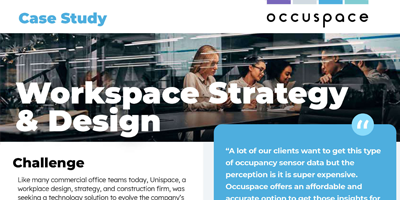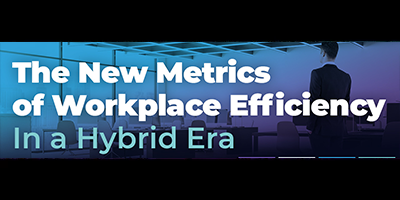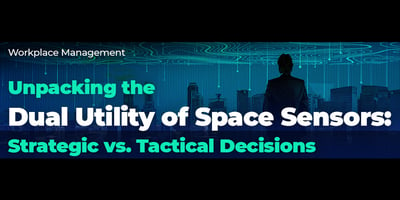08/02/24 - Like many commercial office teams today, Unispace, a workplace design, strategy, and...
Unlocking Hidden Insights: How Comprehensive Data Maximizes Office Efficiency
07/23/24 
In today's rapidly shifting work environment, understanding office space utilization is crucial for improving workplace efficiency and employee satisfaction. With the rise of hybrid work models, the role of data in shaping our office environments has become more significant. However, the challenge lies in gathering accurate data at scale. Traditional methods often rely on limited scope assessments, which can lead to incomplete and misleading insights.
The Irony of Limited Data
It's ironic that in an age where we value the accuracy of the data from devices we use to capture space utilization metrics like visitor counts, occupancy, and dwell times, we still settle for limited data. It's ironic that in an age where we value the accuracy of the data from devices we use to capture space utilization metrics like visitor counts, occupancy, and dwell times, we still settle for limited data. Short-term assessments, though better than manual methods like clipboard studies, only provide a snapshot in time. This limited data can lead to inaccurate assumptions about space usage. Additionally, the cost of technology and the complexity of installations have created barriers to accessing data at scale. Comprehensive data collection challenges this status quo by capturing concurrent data, revealing the true nature of space utilization. This allows organizations to make decisions based on a full understanding of how spaces are used.
The Need for Comprehensive Data Collection
“To truly grasp space utilization, it's essential to use data collected across entire buildings rather than relying on partial assessments. ”
To truly grasp space utilization, it's essential to use data collected across entire buildings rather than relying on partial assessments. To truly grasp space utilization, it's essential to use data collected across entire buildings rather than relying on partial assessments Installing occupancy sensors on every floor and in every building ensures that all areas are monitored, providing a complete and detailed picture of how spaces are used. This method captures real-time user behaviors, allowing for immediate analysis and adjustments, leading to more reliable insights essential for effective space management.
A Real-World Example
Consider 10 floors of office space in a building where security badge data shows daily occupancy hovering at 55%.
Apart from how many people show up each day, in what building and maybe on what floor, the organization wants to also know where people go when they’re in the office, what areas they use, how many people use them, and for how long.
If they conduct a manual study, the data they capture won’t reflect the number of people using similar space types at the exact same time, making it difficult to compare demand and user preferences for space accurately.
Using technology but only for limited scopes of space improves the data but still requires assumptions and guesses about the entire building or portfolio, which often aren’t accurate. Using technology—but only for limited scopes of space—improves the data but still requires assumptions and guesses about the entire building or portfolio, which often aren’t accurate.However, if they deploy technology to capture data wall to wall, even for just 3 to 6 months, they can obtain data for 100% of the space with 95% accuracy. This level of detail provides a clear picture of how space is really used, based on observed behaviors visible at a macro level. It's this level of insight that makes the difference between just making data-driven decisions and making data-driven decisions with confidence.
Avoiding Hidden Costs: The True Value of Comprehensive Data Collection
Although limited-scope area-based assessments may seem inexpensive initially, they can become more costly in the long run. Repeated setups and sensor relocations, coupled with making assumptions about an entire building or portfolio, can lead to significant missed opportunities and costly strategic errors that only become apparent later.
Phil Kirschner at McKinsey & Co shared in a post on LinkedIn recently that architecture and design firms often wish for a guaranteed budget to address and enhance their clients' spaces post-occupancy, stating, “the likelihood of getting it right from day one is nearly impossible.” He suggests that with additional funding, firms could significantly improve post-project support and outcomes for occupants and their employers.
Why not avoid post-project improvements from the start? A key challenge is gaining visibility into strategic truths rather than just tactical decisions aided by technology. Despite its potential to deliver data at scale, tech adoption is stifled by high costs and profitable manual processes. This forces designers and strategists to cycle through tactical decisions without a solid strategic foundation, leading to costly and ongoing experimentation.
Strategic Investment vs. Short-Term Savings: Why Comprehensive Coverage Pays Off
Often, many opportunities are overlooked until it's too late for cost-effective interventions. Effective strategic decision-making demands accurate, evidence-based data at scale. Technology should be seen as a strategic investment that ensures data-supported, sustainable outcomes right from the start. However, the high cost of sensor technology has been a barrier, preventing a full understanding of space utilization and leading to a need for costly fixes after the fact. This ultimately increases long-term costs for businesses and undermines the potential benefits of comprehensive data collection.
Comprehensive coverage proves more cost-effective over time and with Occuspace, the cost barrier is eliminated. Continuous data collection avoids the additional labor and costs associated with moving occupancy sensors, providing a steady stream of valuable insights. The ROI for full portfolio coverage is incredibly high too when the cost to implement is less than 1% of annual rent costs. Considering the shrinking demand for space, validating your real estate needs will yield a much higher and more sustainable ROI.
The Benefits of Comprehensive Data Collection
“This level of detail allows for immediate, confident, data-driven decisions. ”
The benefits of comprehensive data collection are significant. Short-term assessments can still be ideal when they provide wall-to-wall coverage. The data points collected by occupancy sensor technology in such comprehensive assessments reveal real patterns of use behaviors quickly. This level of detail allows for immediate, confident, data-driven decisions.Even for short term assessment scenarios, having comprehensive data for whatever timeframe, improves an organization's understanding to enable better planning and provisioning of spaces effectively.
Transforming Workplace Optimization
Scale transforms workplace optimization by offering a holistic understanding of nuanced behaviors, showing how many people are using spaces, where they are, and when they are present. Observing these factors simultaneously changes how you plan for employee needs, allowing for the identification of patterns that demonstrate trends and seasonality. This macro-level view enables organizations to consider options for addressing ebbs and flows in space usage differently, which is only possible with comprehensive data.
The Future of Real-Time Monitoring
The emerging need to always monitor office space is becoming evident...The emerging need to always monitor office space is becoming evident, especially if operational excellence and enhancing in-office user experiences truly matter. Managing shared spaces is very different from managing spaces assigned 1:1. Facility management has traditionally been reactionary due to a lack of visibility. While determining what is truly actionable remains challenging, always-on monitoring of space enables threshold management in real-time. This provides early signals of potential emerging problems before they become critical or even detrimental, ensuring proactive space management.
Personal Insight: The Value of Scale
As a veteran in workplace research and analytics, I’ve seen firsthand that comprehensive data collection is often undervalued due to cost and technology barriers. Companies frequently rely on historical security badge and Wi-iFi data, which offer broad insights but miss critical details.
Today's office planning demands more than moment-in-time or limited scope assessments. On-site, the combination of area, people, and time spent offers essential insights into actual space usage and demand. By observing these factors at scale, independent of current design constraints, we uncover empirical work patterns unique to each organization’s culture. This approach reveals whether work patterns are more individual or collective. In a world where balancing individual choice with team needs is essential, understanding these nuanced work patterns is key to designing spaces that support both personal and collaborative requirements, fostering a more engaged and productive workforce.
We’re interested in your opinion on the biggest benefit of scaling data collection. Participate in our poll and contribute to shaping the future of workplace optimization!
Your comments, thoughts and ideas are welcome.
--- Sandra Panara | Director, Growth & Innovation, Occuspace
Occuspace provides an affordable, easy-to-deploy occupancy monitoring system that can accurately measure real-world space utilization patterns while preserving occupant privacy. To learn more, visit us or set up a free consultation at https://web.occuspace.io/
Stay Informed - Subscribe Today!





